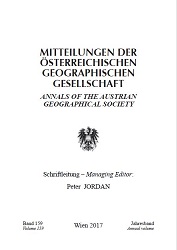
Mitteilungen der Österreichischen Geographischen Gesellschaft Band 159/2017, pp. 7-22, 2019/05/24
159. Jg. (Jahresband), Wien 2017

The evolution of cities is a major issue because it affects the majority of the world population. It is in cities that solutions must be invented to solve the problems of sustainable development in terms of quality of life, of resource management, of intelligent integration of technological and cultural innovation and of social cohesion, at the local and the global scales. The diversity of cities is such that it might seem difficult to develop a scientific knowledge about them for sustaining policies. However, cities have long been interdependent and organised into systems of cities; they co-evolve through the multiple relationships, which connect them into networks for the exchange of materials, investments, people or information. These interdependencies drive and constrain the evolution of each city in the system, according to a complex set of dynamics, which exhibit patterns regular enough to help understanding and even predicting certain trends. For anticipating urban future, geographers have since long developed a theoretical framework relying on the observation, not only of the few megacities global stars but of thousands of cities and towns taken in a variety of world regions. These empirical observations were scrutinised through analytic methods inspired from the dynamics of complex systems and data, and processes are now integrated into computer simulation models, which are able to reconstruct the stylised facts and trends observed. This consolidates an evolutionary theory of urban hierarchies according to which the urban geo-diversity is a necessary condition for continuing the major function of cities and towns that are altogether remarkably efficient socio-spatial adaptors in the long run of human history.
Keywords: Cities, system of cities, urban dynamics, modeling, world urbanisation